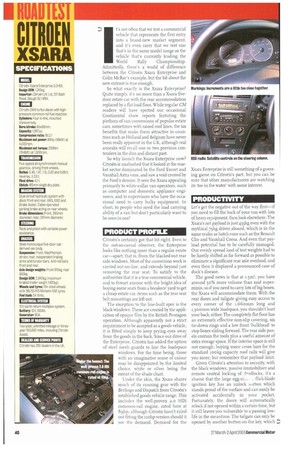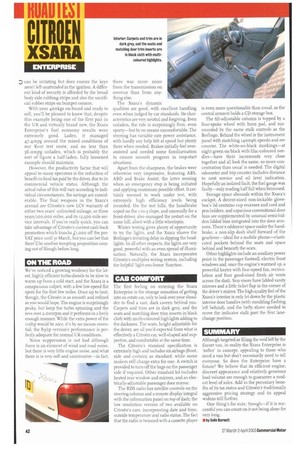CITROEN
Page 40

Page 42

If you've noticed an error in this article please click here to report it so we can fix it.
XSARA
t's not often that we test a commercial vehicle that represents the first entry into a brand-new market segment, and it's even rarer that we test one that's in the same model range as the vehicle that's currently leading the
World Rally Championship. Admittedly, there's a world of difference between the Citroen Xsara Enterprise and Colin Mc Rae's example, but the bit about the new entrant is true enough.
So what exactly is the Xsara Enterprise? Quite simply, it's no more than a Xsara fivedoor estate car with the rear accommodation replaced by a flat load floor. While regular CM readers will have spotted our occasional Continental show reports featuring the plethora of van conversions of popular estate cars, sometimes with raised roof lines, the tax benefits that make them attractive in countries such as Holland and Belgium have never been really apparent in the UK. although real anoraks will recall one or two previous contenders in the dim and distant past.
So why launch the Xsara Enterprise now Citroen is unabashed that it looked at the market sector dominated by the Ford Escort and Vauxhall Astra vans, and saw a void created by the Ford's demise. It sees the Xsara appealing primarily to white-collar van operators, such as computer and domestic appliance engineers, and to supervisors who have the occasional need to carry bulky equipment. In short, to people who need the load carrying ability of a van but don't particularly want to be seen in one!
PRODUCT PROFILE
Citroen's certainly got tha I bit right. Even to the not-so-casual observer. the Enterprise looks like nothing more than a regular estate car—apart, that is, from the blacked-out rear side windows. Most of the conversion work is carried out on-line, and extends beyond just removing the rear seat. To satisfy to the authorities that it is a true commercial vehicle, and to thwart anyone with the bright idea of buying some seats from a breakers' yard to get a cheap estate car, items such as the rear seat belt mountings are left out.
The exception to the line-built spec is the black windows. These are created by the application of opaque film by the British Pentagon operation. Although apparently not a strict requirement to be accepted as a goods vehicle, it is fitted simply to keep prying eyes away from the goods in the back. Since our drive of the Enterprise. Citroen has added the option of steel mesh guards to line the loadspace windows. For the time being, those with an imaginative sense of colour may be disappointed by the limited choice, white or silver being the extent of the shade chart.
Under the skin, the Xsara shares much of its running gear with the Berlingo and Dispatch from Citroen's established goods vehicle range. This includes the well-proven 2.0 HDi common-rail engine, rated here at 89hp, although Citroen hasn't ruled out fitting the rrohp version should it see the demand. Demand for the
Xsara Enterprise is still something of a guessing game on Citroen's part, but you can be sure that other manufacturers are watching its toe in the water' with some interest.
ri JD. AbilkArid.=
Let's get the negative out of the way first—if you need to fill the back of your van with lots of heavy equipment, then look elsewhere. The Xsara's net payload is just 435kg even with the mythical 75kg driver aboard, which is in the same realm as hatch-vans such as the Renault Clio and Vauxhall Corsa. And even that payload potential has to be carefully managed. Our evenly spread load of test weights had to be hastily shifted as far forward as possible to eliminate a significant rear axle overload, and even then it displayed a pronounced case of duck's disease.
The good news is that at 1.5m3, you have around 50% more volume than said superminis, so if you need to carry lots of big boxes, the Xsara will accommodate them. With the rear doors and tailgate giving easy access to every corner of the 1,66omm long and 1,300mm wide loadspace, you shouldn't hurt your back, either. The completely flat floor has an extremely effective non-slip covering, six tie-down rings and a low front 'bulkhead' to stop boxes sliding forward. The rear side panels contain the tools plus a useful amount of extra storage space. If the interior space is still not enough. buying some cross bars for the standard rookg capacity roof rails will give you more, but remember that payload limit.
Given Citroen's attention to security, with the black windows, passive immobiliser and remote central locking of .1..adlocks, it's a shame that the large egg-s/i.., _ flick-blade ignition key has an unlock outton which stands proud of the surface and can easily be activated accidentally in your pocket. Fortunately, the doors will automatically relock if not opened within a certain time, but it still leaves you vulnerable to a passing lowlife in the meantime. The tailgate can only be opened by another button on the key, which
can be irritating but does ensure the keys aren't left unattended in the ignition. A different kind of security is afforded by the broad body side rubbing strips and also the sacrificial rubber strips on bumper corners.
With your 400kgs on-board and ready to roll, you'll be pleased to know that, despite this example being one of the first pair in the UK and virtually brand new, the Xsara Enterprise's fuel economy results were extremely good. Laden, it managed 47.4mpg around the mixed conditions of our Kent test route, and no less than 56.ompg unladen, which is probably the sort of figure a half-laden, fully loosened example should maintain.
However, the productivity factor that will appeal to many operators is the reduction of benefit-in-kind tax paid by the driver, due to its commercial vehicle status. Although the actual value of this will vary according to individual circumstances, the savings are considerable. The final weapons in the Xsara's arsenal are Citroen's new LCV warranty of either two years' unlimited mileage. or three years/100,000 miles, and its 12,500 mile service intervals. If you're really quick. you can take advantage of Citroen's current cash-back promotion which knocks £i,00o off the preVAT price until p March. but you can bet that there'll be another tempting proposition coming out of Slough before long.
ON THE ROAD
We've noticed a growing tendency for the latest, highly efficient turbo-diesels to be slow to warm up from a cold start, and the Xsara is a conspicuous culprit, with a few low-speed flat spots for the first few miles. Once up to heat, though, the Citroen is as smooth and refined as you would hope. The engine is surprisingly peaky, but keep the turbo spinning and the revs over z,000rpm and it performs in a lively enough manner. While the extra power of the nohp would be nice, it's by no means essential; the 89hp version's performance is perfectly adequate for normal UK conditions.
Noise suppression is not bad although there is an element of wind and road noise, but there is very little engine noise, and what there is is very soft and unintrusive—in fact, there was more noise from the transmission on overrun than from anything else.
The Xsara's dynamic qualities are good. with excellent handling even when judged by car standards. Its characteristics are very neutral and forgiving. Even unladen, the ride is surprisingly firm, even sporty—but by no means uncomfortable. The steering has variable rate power assistance, with hardly any help felt at speed but plenty there when needed. Brakes initially feel overassisted and needed some familiarisation to ensure smooth progress in stop-start situations.
Apart from the sharpness, the brakes were otherwise very impressive, featuring ABS, ABD and Brake Assist, the latter sensing when an emergency stop is being initiated and applying maximum possible effort. It certainly seemed to work under test, with extremely high efficiency levels being recorded. On the test hills, the handbrake coped on the 1-in-3 slope, and unusually for a front-driver, also managed the restart on the same hill, albeit with a little wheelspin.
Winter testing gives plenty of opportunity to try the lights, and the Xsara shares the Berlingo's irritating delay in dipping the headlights. In all other respects, the lights are very good, powerful with an even spread of illumination. Naturally, the Xsara incorporates Citroen's multiplex wiring system, including the helpful light-you-home' function.
CAB COMFORT
The first feeling on entering the Xsara Enterprise is the strange sensation of getting into an estate car, only to look over your shoulder to find a vast, dark cavern behind you. Carpets and trim are in dark grey, and the seats and matching door trim inserts in black cloth with multi-coloured highlights adding to the darkness. The seats, height adjustable for the driver, are all you'd expected from what is effectively a Citroen car, well-shaped and supportive, and comfortable at the same time.
The Citroen's standard specification is extremely high and includes six airbags (front, side and curtain) as standard, while some makers still charge extra for one. A switch is provided to turn off the bags on the passenger side if required. Other standard kit includes heated rear window and mirrors, and an electrically-adjustable passenger door mirror.
The RDS radio has satellite controls on the steering column and a remote display integral with the information panel on top of dash, the low resolution version of two available on Citroen's cars, incorporating date and time, outside temperature and radio status. The fact that the radio is twinned with a cassette player
is even more questionable than usual, as the central armrest holds a CD storage box.
The tilt-adjustable column is topped by a four-spoke wheel with horn pad, and surrounded by the same stalk controls as the Berlingo. Behind the wheel is the instrument panel with matching 140mph speedo and rev counter. The white-on-black markings—at night green on black with lilac-coloured needles—have their increments very close together and all look the same, so more concentration than usual is needed. The digital odometer and trip counter includes distance to next service and oil level indication. Hopefully an isolated fault, the fuel gauge was faulty—only reading half full when brimmed.
Storage space abounds within the Xsara's cockpit. A decent-sized non-lockable glovebox's lid contains cup recesses and card and pen holders, and capacious conventional door bins are supplemented by unusual semi-hidden lidded bins integrated into the door armrests. There's oddment space under the handbrake, a non-slip dash shelf forward of the gearlever—ideal for a mobile phone—elasticated pockets behind the seats and space behind and beneath the seats.
Other highlights include an auxiliary power point in the passenger footwell, electric front windows and, once the engine's warmed up, a powerful heater with four-speed fan, recirculation and four good-sized fresh air vents across the dash. Sun visors have lidded vanity mirrors and a little ticket flap in the corner of the driver's mirror. The high-quality feel of the Xsara's interior is only let down by the plastic interior door handles (with moulding flashing left behind), and the hefty shove needed to move the indicator stalk past the first lanechange position.
SUMMARY
Although targeted as filling the void left by the Escort van, in reality the Xsara Enterprise is 'softer' in concept, appealing to those who need a van but don't necessarily need to tell everyone. So does the Enterprise have a future? We believe that its efficient engine, discreet appearance and relatively generous load volume are enough to guarantee a modest level of sales. Add in the pecuniary benefits of its tax status and Citroen's traditionally aggressive pricing strategy and its appeal widens still further.
One thing's for sure, though—if it is successful you can count on it not being alone for very long.
• by Can Barnett












































































































































































